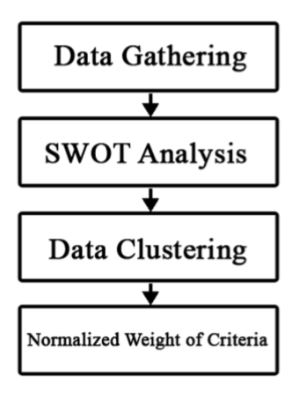Competitiveness Evaluation Techniques for Cosmeceuticals E-Commerce Platform
Main Article Content
Abstract
Currently, the popularity of cosmeceuticals e-commerce is continuously increasing. A competition level among entrepreneurs is higher precisely, especially in the e-commerce platform. As a result, this situation causes to strengthen the competitiveness of several businesses. However, an evaluation of business operation planning which directly associates with the competitiveness of entrepreneurs is still the main issue. Therefore, this study proposes the methodology to define the cosmeceuticals e-commerce competitiveness through SWOT analysis, useful clustering methods including Self-Organizing Map (SOM) and K-means clustering, and Normalized Weight of Criteria for competitiveness criteria evaluation. The SWOT analysis is a reliable algorithm, which can adequately be used to evaluate the business performance with valid questionnaires. It provides the grouped attributes as 4 groups including Strengths, Weaknesses, Opportunities, Threats. Moreover, the appropriated factors result from the previous step will be clustered by SOM and K-means clustering for better data interpretation. SOM calculated 203 instances into 3 clusters; Low, High, No Class with 18 sec for execution time and 94.98% for accuracy. Meanwhile, K-means clustered previous dataset into 2 groups; high performance business and low performance business with 91.33% accuracy. In addition, the clustered data will be specified by Normalized Weight of Criteria for most influential criteria of Strengths, Weaknesses, Opportunities, and Threats factors to accomplish the high Competitiveness level of entrepreneurs. The results from this analysis can definitely help cosmeceuticals entrepreneurs to enhance the business strategy and advanced planning.
Article Details
References
[2] C.M. Choi, and D.S Berson, “Cosmeceuticals. Semin. Cutan,” Med. Surg, vol.25, pp. 163-168, 2006.
[3] E.Turban, L. Volonino, G. R. Wood, and J. C. Sipior, “Profitable Business Growth,” in Information Technology for Management: Advancing Sustainable , Wiley, 2013.
[4] Information Economy Report 2015: Unlocking the Potential of E-commerce or Developing Countries. GWD : United Nations Publication, 2018.
[5] N. Arora, S. Agarwal, and R. S. R. Murthy, “Latest technology advances in cosmeceuticals,” International Journal of Pharmaceutical Sciences and Drug Research, vol.4, pp. 168-182, 2012.
[6] M. M. Kapoor, and M. S Si, “Strategic analysis of cosmeceuticals with special reference to antiaging creams,”
International Journal of Business and Management Invention, vol.3, pp.44-52, 2014.
[7] L. Rokach, and O.Maimon, “Clustering methods,” in Data mining and knowledge discovery handbook, Springer, Boston, MA, pp. 321-352.
[8] D.Zhao, and X.Tang, “Cyclizing clusters via zeta function of a graph,” In Advances in Neural Information Processing Systems, pp. 1953-1960, 2009.
[9] X K. Y. Chan, “A SWOT study of the development strategy of Haier Group as one of the most successful Chinese enterprises,” International Journal of Business and Social Science, vol.2, no.11, pp.147-153, 2011.
[10] S. Ghazinoory, A. Esmail Zadeh, and A. Memariani, “Fuzzy SWOT analysis,” Journal of Intelligent & Fuzzy Systems, vol.18, pp.99-108, 2007.
[11] T. P. Murtha, and S. A. Lenway, “ Country capabilities and the strategic state: How national political institutions affect multinational corporations’ strategies,” Strategic management journal, vol.15, pp. 113-129, 1994.
[12] A. Ajitabh, and K. Momaya, “ Competitiveness of firms: review of theory, frameworks and models,” Singapore management review, vol.26, pp. 45-61, 2004.
[13] L. S. Feldt, and R. Brennan, “RL Reliability,” in Educational measurement, 3rd, 1989, pp. 105-146.
[14] L. J. Cronbach, “Coefficient alpha and the internal structure of tests,” psychometrika, vol.16, pp. 297-334, 1951
[15] T. Kohonen, “Self-organized formation of topologically correct feature maps,” Biological cybernetics, vol.43, pp.59-69, 1982.
[16] A. Ciampi, and Y. Lechevallier, “Clustering large, multi-level datasets: an approach based on Kohonen self-organizing maps,” In European Conference on Principles of Data Mining and Knowledge Discovery, Springer, Berlin, Heidelberg, pp. 353-358, 2000.
[17] A. A. Akinduko, E. M. Mirkes, and A. N. Gorban, “SOM: Stochastic initialization versus principal components,”
Information Sciences, 364-365, pp. 213-221, 2016.
[18] C. C. Sun, and G. T. Lin,“Using fuzzy TOPSIS method for evaluating the competitive advantages of shopping websites,” Expert Systems with Applications, vol.36, pp. 11764-11771, 2009.


